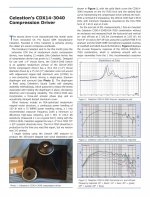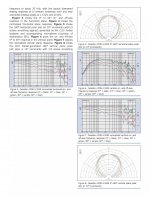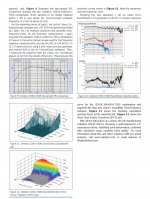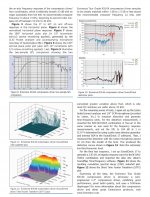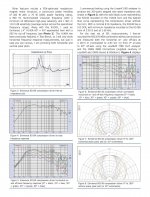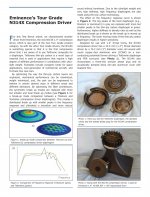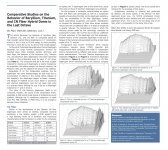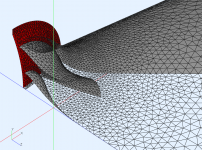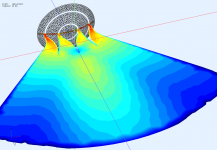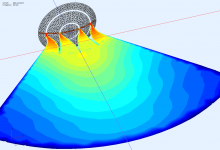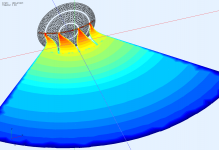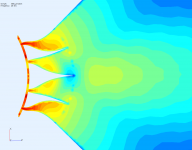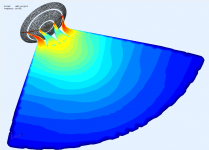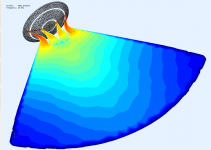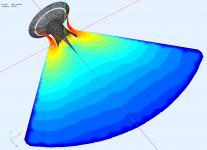We are not at the same page here, I guess. Actually, the compression ratio for the above example is 8:1 as it is the total slot entrance area that matters, not the throat area (which is not even clearly defined in this case). And I really do think that if done as I suggest the velocity entering the waveguide (i.e. at the exit of the slots) is much more closer to radial than for the diaphragm alone.
Unfortunately my first attempt for a simulation ended a while ago for "out of memory"...
Edit: I checked again and it is in fact more like 7:1 as I made some changes in the meantime. For a home use I think it would be harmless to reduce it.
Robin Christ from Coda Audio clued me into a neat trick:
Run your jobs from AWS.
For instance, an AWS C5 metal instance has 96 cpus and 192Gb of ram. These aren't "virtual CPUs", this is a dedicated bare metal instance.
My desktop machine costs about $800 and has 16 cores and 48Gb of ram. I can get a typical ABEC job finished in about 30 minutes, generally.
With an AWS C5 instance, it should be possible to knock that down to about 2-3 minutes.
The catch, of course, is the price: they're $8.50 per hour in the Oregon AWS availability zone.
Because of that, you really have to watch the clock. Basically spin up an instance, do your work, spin it back down. (With AWS, the cost of storing a machine image is basically nothing, so the 'trick' is to use it when you need it, then put it back to sleep when you're done.)
Yeah, that was my mistake. It was too late to correct it. But this was really not aimed for performace yet. Just a verification of the whole procedure.Is the outer slot indeed all the way out at the rim?
I control all of this by setting numbers in a script file.
Regarding ABEC, I'm a bit frustrated right now as it seems that the field observation can't use the user provided mesh but uses always a simple plane instead that intersects the model rather randomly. Nevertheless, after dividing the whole thing into several subdomains, it calculates in an acceptable time. BTW, this is for 20 kHz on a 100 kHz mesh grid. The phase plug used is the most simple variant I could think of for the start - two slots, placed more or less randomly. Will need to use a still longer waveguide.
Maybe a polar map from somewhere inside the waveguide will be a better presentation.
Hi mabat,
ABEC3 enables to import field mesh. Picture below illustrates field calculation along horn-like plane.

Btw, it is also worth a try to use another meshing algorithm than Delaunay triangulation. I often use GMSH "packing of parallelograms" triangulation, which quite often ensures a value of "Free term" closer to 0.5 even if the mesh is coarser than Delaunay mesh. Sometimes this trick helps significantly reduce computation time
Thanks again Dmitrij, you made my day!Hi mabat,
ABEC3 enables to import field mesh. Picture below illustrates field calculation along horn-like plane. ...
I omitted the "Mesh_Properties" section.
Now this will be lovely
Attachments
OK, this will be fun
(color division 1 dB)
You're really up to something special!
When I get back, you've probably experimented with the center channel
Last edited:
I'm thinking about splitting the inner slot into two towards the diaphragm at about half of its length, making a tree-like (fractal) structure. 
Or maybe three slots would just make it.
BTW, the elliptical entrances are quite feasible with Gmsh and it would add no additional cost in the end.

Or maybe three slots would just make it.
BTW, the elliptical entrances are quite feasible with Gmsh and it would add no additional cost in the end.
Last edited:
- Home
- Loudspeakers
- Multi-Way
- Acoustic Horn Design – The Easy Way (Ath4)
